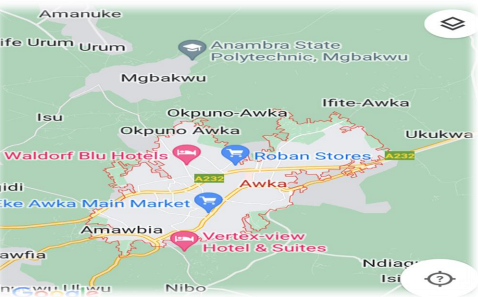Dynamic Power Consumption in Base Transceiver Station in Urban and Rural Setting in Awka, Nigeria using Multi-Attribute Decision-Making Technique

Submission to VIJ 2023-12-02
Keywords
- Base Transceiver Station, Dynamic Power Consumption, Cost-effective Traffic Generation, Multi-attribute decision-making technique
Copyright (c) 2023 Okafor C.S., Okorogu, V.N.

This work is licensed under a Creative Commons Attribution 4.0 International License.
Abstract
The goal of this paper was to lower base transceiver station (BTS) dynamic power consumption. A multi-attribute decision-making technique was implemented that reflects the stochastic nature of cellular networks and guarantees cost-effective traffic generation and improved BTS power consumption performance. Every related candidate or attribute that is taken into consideration to help reduce power consumption is given a utility function, and the candidate with the highest utility value is chosen to meet the target. The Utility function that the Technique selects is the weighted sum of the normalized attributes. In contrast to the works of other authors, which lowered consumption by 20%, the developed dynamic power consumption model cut consumption to 25.14 percent. The two BTS of interest were measured, and the results showed that Mgbakwu BTS has two Peak (Busy) Hour periods: in the morning, 9.55Erlangs from 7.30am to 8.30am, and in the evening, 10.7Erlangs from 8.30pm to 9.30pm. The BTS is located in a rural/residential area. The BTS measurement and analysis for the UNIZIK temporary site revealed that it is located in a commercial/business setting with a morning peak (busy) hour period of 19.1 Erlangs between 10 and 11 a.m. 14.6 Erlangs is the afternoon peak hour, which runs from 3.30 to 4.30 p.m. The traffic generated in the BTS under various load situations is reflected in the relevant Power Consumption for both BTS.
References
- Abdulkadir, B. (2001), GSM: Why NITEL is interested. A house Magazine of the Nigerian Telecommunications Ltd, Vol.5, No. 3, pp.19-21.
- Deruyck, M. W., Vareeken, W., Joseph, B., Lannoo, M., Pickavet, L., Martens, (2010), Reducing power consumption in wireless access networks (overview and recommendations) Progress in Electromagnetic Research, vol. 132, page. 255-274, DOI: 10:22528/PIER 12061301.
- Asouzu, B. (2012), Training Manual for Traffic Engineers – Training Guide for NITEL Service and Maintenance Engineers 2012.
- Nnebe, S.U., Odeh, I.O., Okafor, C.S., & Ugbe, O.C. (2023). Evaluating the level of interference in UMTS/LTE heterogeneous network system. International Journal of Informatics and Communication Technology (IJ-ICT), 12(2), 92-102.
- Nnebe, S.U., Oranugo, C.O., Okafor, C.S., & Odeh, I.O. (2021). The impact of interference on UMTS/LTE network technology in a highly dense environment. International Journal of Innovative Research and Advanced Studies (IJIRAS), 8(11), 48-54.
- Okorogu, V. N., Okafor, C. S. (2023). Improving Traffic Management in a Data Switched Network Using an Adaptive Discrete Time Markov Modulated Poisson Process, European Journal of Science, Innovation and Technology, Vol.3, Iss. 4, pp. 542 – 562.
- Okorogu, V. N., Okafor, C. S., Egbonwonu, E.L. (2023). Improving Resource Management in Virtual Private Network using Modified Dynamic Hose Model, International Journal of Scientific and Technical Research in Engineering, Vol. 8, Iss. 6, pp. 1 – 20.
- ITU Press Release, (2008). Measurement method for energy efficiency of wireless access equipment. (Guideline).
- Humar, I. X. Ge, L. Xiang, M, Jo. Chen, (2011). Rethinking energy efficiency models of Cellular network with embodied energy), IEEE Network, vol. 25, no. 2, page 4, DOI. International Information Management Corporation, (2010). ISSBN: 978-1-905824-16-8.
- Ayang Albert (2016) Power Consumption in Base Station of Telecommunication in Sahel of Cameroon: Typology Based on the Power Consumption – Model and Energy Savings: International Renewable Journal of Energy (IRE), 2016.
- Blume, O. H. Eckhardt, S. Klein, E., Kuehn, W., Wajda, M. (2010). Energy savings in mobile network based on adaptation to traffic statistics), Bell Labs Technical Journal, vol. 15, no. 2, pag.77-94, set. DOI.
- Krishnamacharis, X. Liu, Z. Niu, (2011). Energy saving through dynamic base Station switching in cellular wireless access network), global Telecommunication conference (GLOBECOM 2010), 2010, page. 1-5. DOI: 10.1109/GLOCOM.2010.5683654.
- Nahida Akter, Md Apel Mahmad and Amamullah Mauny Than (2017) A hierarchical Transactive Energy Management for Energy sharing in Neighbouring BTS. 2017, 10, 2098 DOI 103390/en 10122098 www.mdpii.com/journal/energies
- Cseaafrica Challenges and Interventions Needs in the Nigeria Electricity Supply Industry (NESI): http://cseaafroca.org/challenges-and-interventions- needs-in-the-nigeria-electricity-industry-nesi/ visited September 1, 2021
- Conte, A.; Feki, A.; Chiaraviglio, L.; Ciullo, D.; Meo, M.; Marsan, M.A. Cell wilting and blossoming for energy efficiency. IEEE Wireless Communication. 2011, 18, 50-56.
- Roy, S.N. Energy logic: a road map to reducing energy consumption in telecommunications network. In Proceedings of Emerson Network Power. IEEE 30th Telecommunication Energy conference (INTELEC), San Diego, CA, USA, 14-18 September 2008; pp. 1-9
- Etoh, M.; Ohya, T.; Nakayama, T. Energy consumption issues on mobile network systems. In proceedings of International Symposium on Applications and the Internet (SAINT), Turku, Finland, 28 July-1 Auhust 2008; pp. 365-368.
- Conte, A.; Feki, A.; Chiaraviglio, L.; Ciullo, D.; Meo, M.; Marsan, M.A. Cell wilting and blossoming for energy efficiency. IEEE Wireless Communication 2011, 18, 50-56.
- Correia, L. M.; Zeller, D.; Blume, O.; Ferling, D.; Jading, Y.; Godor, I; Auer, G.; van der Perre, Challenges and enabling technologies for energy aware mobile radio network. IEEE Commun. Mag 2010, 48, 66-72
- Marsan, M.A, Meo, M. Energy efficient management of two cellular access networks. ACM SIGMETRICS Perform. Eva. Rev. 2010, doi 10.1145/1773394.1773406.
- Payel Giri, Sudhansu Singh, (2015). An analytical survey of energy consumption and modelling in different areas of ICT networks) International Journal of computer Science and Information Technologies, vol.6 (1), 866-870.
- Lorincz, J. T. Garma, G. Petrovic, (2012). Measurements and modelling of base Station consumption under real traffic loads), Sensor, vol.12, n.4, page 4281-4310, DOI: 3390/s 1204042